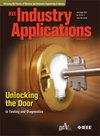基于单极线圈的多负载感应功率传输解耦补偿设计
IF 4.5
2区 工程技术
Q2 ENGINEERING, ELECTRICAL & ELECTRONIC
引用次数: 0
摘要
在以往的多负载中继线圈电感功率传输系统中,为了减少不同单元之间的交叉耦合,通常采用双极线圈。但是,双极线圈结构复杂,能量传输距离短。因此,本文提出的多负载IPT系统采用单极线圈而不是双极线圈。与双极线圈相比,单极线圈会引起任意两个线圈之间的交叉耦合,不仅是同一单元内的线圈,而且不同单元之间的线圈也会产生交叉耦合。为了补偿同一单元内部的交叉耦合,采用了基于t型去耦原理的电容补偿。然后,为了获得更好的恒流特性,根据不同单元恒压回路中线圈之间的比例电流特性进行补偿。分析了影响负载电流衰减的因素,为实现更好的恒流特性提供了指导。最后,制作了一个三负载IPT系统,并验证了该系统的电容补偿效果和恒流特性。经测量,系统最高可达效率约为86.8%。本文章由计算机程序翻译,如有差异,请以英文原文为准。
Decoupling Compensation Design for Multi-Load Inductive Power Transfer Utilizing Unipolar Coils
In the previous inductive power transfer (IPT) system with repeater coils for multiple loads, bipolar coils were usually adopted to reduce the cross-coupling between different units. However, the bipolar coil has a complex structure and features a short energy transmission distance. Thus, unipolar coils rather than bipolar coils are adopted in the proposed multi-load IPT system in this paper. Compared to bipolar coils, unipolar coils cause cross-coupling between any two coils, not only those inside the same unit but also those among different units. To compensate for the cross-coupling inside the same unit, capacitor compensation based on the T-type decoupling principle is adopted. Then, to achieve better constant current characteristics, the cross-couplings between coils in constant voltage (CV) loops of different units are compensated according to their proportional current characteristics. Moreover, this paper analyzes the factors affecting the load current attenuation and provides guidance for achieving better constant current characteristics. Finally, a three-load IPT system is fabricated, and the capacitance compensation effect and constant current characteristics of the system are verified. The maximum reachable system efficiency is about 86.8% through measurement.
求助全文
通过发布文献求助,成功后即可免费获取论文全文。
去求助
来源期刊

IEEE Transactions on Industry Applications
工程技术-工程:电子与电气
CiteScore
9.90
自引率
9.10%
发文量
747
审稿时长
3.3 months
期刊介绍:
The scope of the IEEE Transactions on Industry Applications includes all scope items of the IEEE Industry Applications Society, that is, the advancement of the theory and practice of electrical and electronic engineering in the development, design, manufacture, and application of electrical systems, apparatus, devices, and controls to the processes and equipment of industry and commerce; the promotion of safe, reliable, and economic installations; industry leadership in energy conservation and environmental, health, and safety issues; the creation of voluntary engineering standards and recommended practices; and the professional development of its membership.
 求助内容:
求助内容: 应助结果提醒方式:
应助结果提醒方式:


